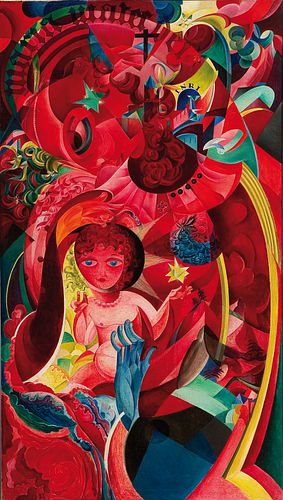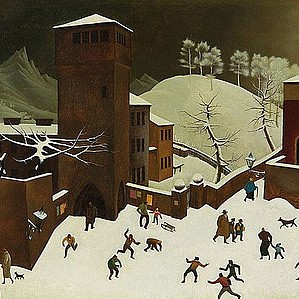OTTO RODEWALD (Schöningen 1891 - 1960 Hamburg) Maria Mater Dei, 1920
Lot 165
Estimate:
EUR€40,000 - EUR€80,000
$43,478.26 - $86,956.52
Absentee vs Live bid
Two ways to bid:
- Leave a max absentee bid and the platform will bid on your behalf up to your maximum bid during the live auction.
- Bid live during the auction and your bids will be submitted real-time to the auctioneer.
Bid Increments
| Price | Bid Increment |
|---|---|
| EUR€0 | EUR€10 |
| EUR€100 | EUR€50 |
| EUR€700 | EUR€100 |
| EUR€1,000 | EUR€200 |
| EUR€3,000 | EUR€300 |
| EUR€3,600 | EUR€400 |
| EUR€4,000 | EUR€500 |
| EUR€7,000 | EUR€1,000 |
| EUR€16,000 | EUR€2,000 |
| EUR€30,000 | EUR€3,000 |
| EUR€36,000 | EUR€4,000 |
| EUR€40,000 | EUR€5,000 |
About Auction
By Widder Auctions
May 19, 2022
Set Reminder
2022-05-19 11:00:00
2022-05-19 11:00:00
America/New_York
Bidsquare
Bidsquare : Masterpieces
https://www.bidsquare.com/auctions/widder-auctions/masterpieces-9287
Masterpieces of classical modernism by Austrian and international artists coming up for auction in Vienna on May 19th Widder Auctions office@widderauktionen.com
Masterpieces of classical modernism by Austrian and international artists coming up for auction in Vienna on May 19th Widder Auctions office@widderauktionen.com
- Lot Description
OTTO RODEWALD*
(Schöningen 1891 - 1960 Hamburg)
Maria Mater Dei, 1920
oil/canvas, 94,5 x 54 cm
monogrammed R and dated 1920
depicted in Alexander Friedrich, Otto Rodewald, Heinrich Stegemann, Hamburg 1970, Nr. 58
Provenance: collection Dr. Thiede Munich, private collection Germany, European private collection
ESTIMATE € 40.000 - 80.000
German painter and graphic artist of the 20th century. Main representative of the Hamburg avant-garde. From 1909 at the Landeskunstschule in Hamburg with Carl Otto Cscheska, together with Alexander Friedrich and Anne-Marie Vogler, among others. Early influences of Art Nouveau and Expressionism. Deployed in World War I, suffered severe Blue Cross poisoning. From 1921 member of the Hamburg Secession, the Hamburg Artists' Association and co-founder of the art club Die Insel. From the end of the 1920s, travels to the Mediterranean region, Africa and the Near East. Lived from 1929 to 1931 in Sidi Bou Saïd, an artists' village in Tunisia. In 1937, several paintings destroyed during the Nazi Degenerate Art campaign. Stylistic development between New Objectivity and Magic Realism with impulses from Cubism and Futurism. Created landscapes and especially allegorical, religious or fantastic figure paintings such as Mary with the Child Jesus. Color intensity and variety of forms comparable to the main work of the bathing boys.
The German painter and graphic artist Otto Rodewald came from a merchant family in Schöningen. Carl Otto Czeschka was one of his teachers during his studies at the School of Applied Arts in Hamburg from 1909 to 1914, and his designs, based on Viennese Art Nouveau, inspired his early sketches. Rodewald was a versatile painter who created important works in different stylistic phases. His works were exhibited in the Hamburger Kunsthalle and in the Schleswig-Holstein state museums amobg others. In 1910 Rodewald won second prize in the competition for the design of monograms and signets. 1921 he joined the circle of the Hamburg Secession, of which he became an official member seven years later. He undertook study trips to Switzerland, France, Italy and the Middle East and lived in Tunisia from 1929 to 1931. He is considered one of the most important representatives of Hamburg Expressionism, more precisely "Revolutionary Expressionism", in which a wide variety of stylistic influences were mixed. In this sense, Rodewald combined elements of Symbolism, Japonism, Art Nouveau, Expressionism, Futurism and New Objectivity (Neue Sachlichkeit) into a homogeneous personal style. Several of his works were confiscated from the Hamburger Kunsthalle in 1937 as “degenerate art”. Otto Rodewald's picture of Maria and the child Jesus is reminiscent of the artist's famous "bathing boys" that the artist created several times, both in terms of the expressive colors and the ornamental detail of the expressive, crystalline composition. During the First World War, Otto Rodewald belonged to an assault battalion. He was wounded several times in trench warfare and suffered the rest of his life from the effects of Blue Cross poisoning. In quiet hours, horror overcame him and dreamlike images of plants and Madonnas came over him. At that time, Rodewald was trying to overcome what he had experienced by erecting walls around himself "only out of color and form". The works that emerged from this desire are not only important for the painter himself, but with their expressive, crystalline composition also for that whole era. This fantastically romantic style however, Rodewald had essentially already acquired at the Hamburg School of Applied Arts. The forms from which Rodewald composes his pictures are, in the absence of acute angles, at the same time calm and yet full of movement, an effect that is accentuated intensely by the expressive color. The depiction of Mary with the baby Jesus is like the "bathing boys", characterized by a mysterious dreamlike glow and modeled from red, blue and green tones, with the red clearly dominating. The formula "maria mater dei" (Mary, Mother of God) from the Ave Maria is written in Gothic minuscule in a suggested nimbus that covers the head of the Mother of God like a veil. Immediately below, a cross and the sequence of letters INRI, the usual abbreviation of the inscription on the cross “Iesus Nazarenus Rex Iudaeorum” (Jesus of Nazareth, King of the Jews) in Christian iconography, refer to the Passion. Maria lovingly bends over the child and caresses his head, which is surrounded by a simple nimbus. A radiance emanates from Christ, the Word of God made flesh; he has raised his right hand in a gesture of speech or blessing and offers us a glimpse of the brightly lit heavenly Jerusalem, while in his left hand he presents a floating bright yellow star. This star corresponds in shape and size to a green star that hovers in front of the Blessed Mother's face. Christ meets us here on the one hand as the light of the world, on the other hand as the copula of the universe, as mediator between God and the world. In this magical, fantastic depiction, earthly motherly love is combined with the transcendence of the timeless act of salvation.
PLEASE NOTE:
The purchase price consists of the highest bid plus the buyer's premium, sales tax and, if applicable, the fee of artists resale rights. In the case of normal taxation (marked ° in the catalog), a premium of 24% is added to the highest bid. The mandatory sales tax of 13% is added to the sum of the highest bid and the buyer's premium. The buyer's premium amounts to 28% in case of differential taxation. The sales tax is included in the differential taxation. - Shipping Info
-
Shipping
We will send you the invoice shortly after the auction. As soon as we have recieved the amount, the art can be picked up at Johannesgasse 9-13, 1010 Vienna. Please note that the buyer is responsible for pick-up and shipping of the lot.
Should you wish to ship your items, please contact: Mailboxes Email: oper@mbe-co.at Tel: 01 5128855
Please note that storage fees may apply, should the pieces not be picked up within 14 days after invoicing for domestic and 28 days for international transportation.
Our team will be happy to assist you with any further information at office@widderauktionen.com or at 0043 676 555 66 10.
-
- Buyer's Premium



 EUR
EUR CAD
CAD AUD
AUD GBP
GBP MXN
MXN HKD
HKD CNY
CNY MYR
MYR SEK
SEK SGD
SGD CHF
CHF THB
THB













